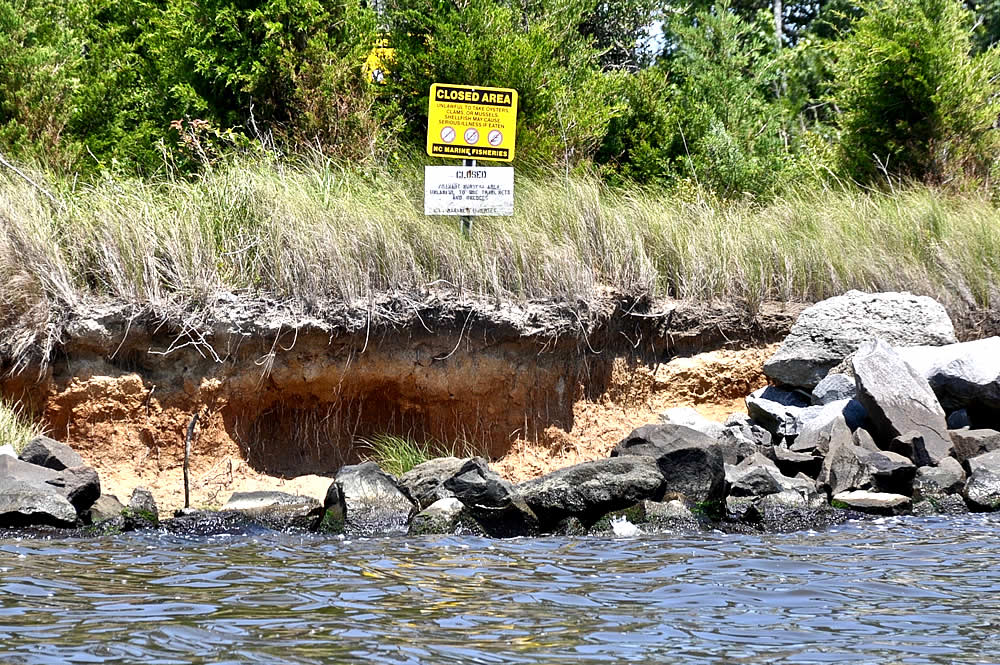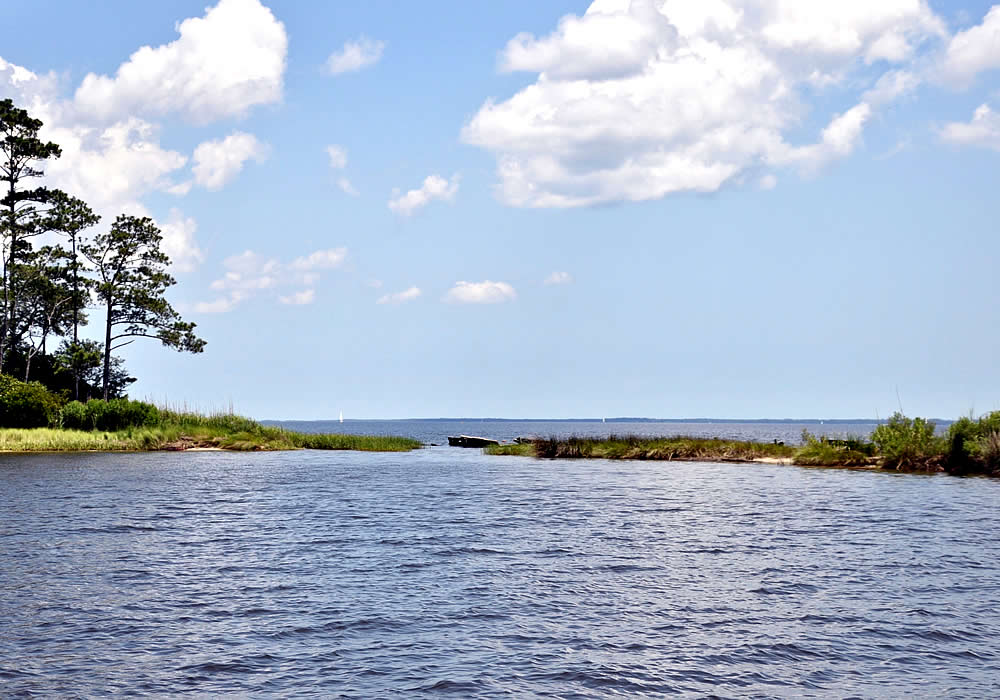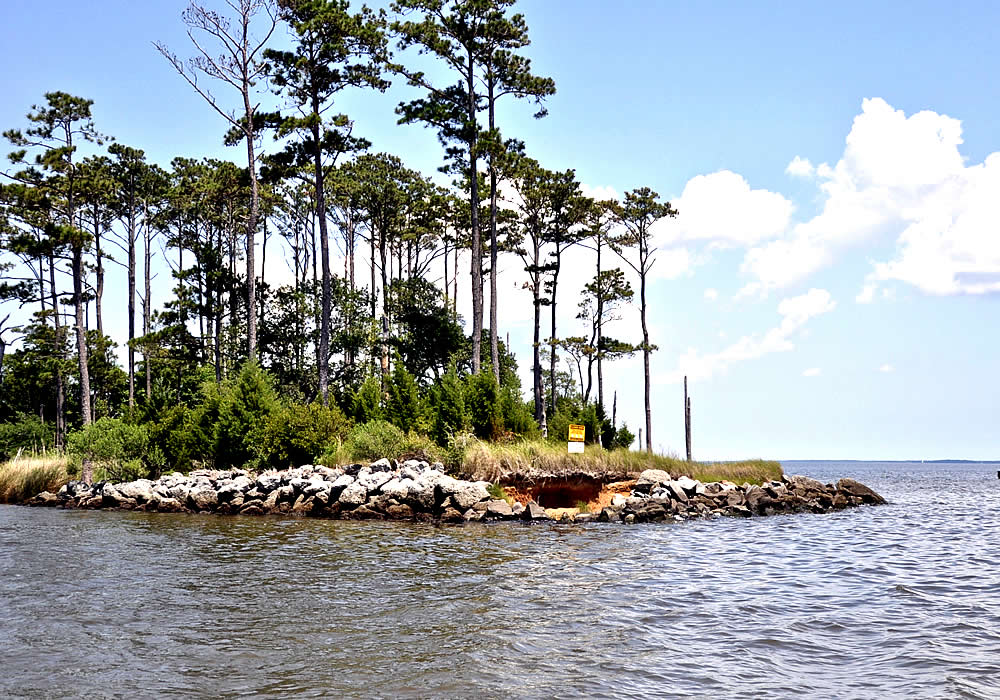It's Wednesday December 17, 2025
February 23, 2018
Currently, there are two projects under consideration in the Whittaker Creek area: a partially funded, resident-driven dredging project for Whittaker Creek channel, and a proposal examining the erosion and restoration of Whittaker Point. They are two separate projects, but they are related. Dredging is on hold until the Town and owners of the Point determine how to tackle the preservation and restoration of the land.Here’s the lay of the land.
Commissioners, the Town Manager, and members of the public watched and discussed a presentation on the erosion of Whittaker Point at the January Quarterly Workshop. Jim Blackerby, a geologist who lives creekside near Whittaker Point, prepared and delivered the presentation. Dr. Lexia Weaver, a coastal restoration specialist with the North Carolina Coastal Federation, spoke to the Board and the public about the effects of the erosion and some potential solutions.The Whittaker Creek Dredging ProjectLast May, the Friends of Whittaker Creek (FoWC), a group of private citizens and businesses who own land in and around the Creek, secured a grant to dredge the creek channel, known to many a boater as a place they go aground because of sediment coming in from the river.As with the grant given to Sea Harbor Yacht Club for the dredging of Pierce Creek, the Town is acting as the financial custodian of the grant monies, disbursing funds as required. No current or future Town funds are in use for the dredging. FoWC and private citizens plan to raise the matching funds needed for the grant.
Henry Frazer, an owner of Whittaker Pointe Marina and a member of FoWC, is helping gather those resources but has held off on beginning the dredging work. Commissioner David White said, “Henry Frazer is hesitant in going in and spending a lot of money to dredge the channel if this [filling in of the creek] is going to happen again.”
This brings us to the second project.
Whittaker Point ErosionThe filling in of the channel could be worse if Whittaker Point were not there. Whittaker Point has stuck out, acting as a barricade protecting Whittaker Creek and the shoreline along the Neuse River. Once a single peninsula, erosion has taken a toll. Now Whittaker Point looks like a smaller spit of land with a neighboring island. Riprap placed on the end of the Point years ago is now missing sections.The current wave attenuators in disrepair at the breach of Whittaker Point.Initially, like the FoWC, private owners of the Whittaker Pointe Marina Owners Association sought to bolster Whittaker Point. They were unsuccessful. The needed repairs and preservation techniques are costly. In a Town Meeting last June, Commissioner Charlie Overcash said he talked with some land owners about donating the land to the Town. The reason being that the Town has greater access to funding and grant opportunities than private entities.
Before accepting any land donation, Town Manager Diane Miller and the Town Commissioners said they want to see what grants are out there, the scope of the erosion, and its impact on the Town. Jim Blackerby, a geologist who lives on Whittaker Creek across from the Point had spoken with some Commissioners last year about the problems he saw with the erosion. The Board invited him to present his findings to the public at the January Workshop.
His presentation analyzed contributing factors, the degree of land loss through the years, and his methodologies in determining the extent of the problem. With that data, Mr. Blackerby said the point had approximately 18.5 acres in 1934. His current estimates show there are approximately 3 acres of Whittaker Point remaining.
Here is a shorter version (7 minutes) of Mr. Blackerby’s presentation illustrating the erosion of Whittaker Point over several decades. (The lengthier and more detailed presentation, with references, is available below.)
A longer version (16 minutes) of Mr. Blackerby’s presentation with more detail, more slides, and a list of references.
Mr. Blackerby advocates that something needs to be done. His PowerPoint lays out the consequences to Oriental’s shoreline if Whittaker Point just disappeared. Businesses in the creek, residential and municipal areas along the shoreline, and existing fisheries and salt marshes would feel the impact.
Stabilizing the point would minimize further damage along the coast from future storms and wave energy. As it sits now, the wave attenuators installed at the breach of Whittaker Point are failing. Rock revetments on the point have deteriorated over time. Dr. Lexia Weaver, a coastal scientist working with the North Carolina Coastal Federation since 2007, presented the Town Commissioners and Town Manager with a way forward.
Whittaker Point’s collapsing revetments.Grants, erosion control structures, and preservationIn a phone interview with Dr. Weaver, she said Whittaker Point functions as a barrier island to protect Oriental’s shoreline the same way the Outer Banks protects the Pamlico Sound. The wave energy generated by wind and the long distances waves travel from outlying land masses (the Outer Banks is one) is reduced by the Point before it reaches Whittaker Creek channel. In the past, rock bulkheads have been used to shore up the point.Though they’ve helped, they’re not a permanent solution.
Wave energy “affects the first hard surface that it hits. The hard surface doesn’t absorb it, it reflects it,” Dr. Weaver explained. “Energy doesn’t have anywhere to go, so it ends up scouring the marsh in front of the bulkhead and you lose land. Living shorelines and wave attenuators absorb the energy. The wave energy and some of the water goes through the attenuator, so it slows it down and doesn’t block it off. So that eliminates that scour in front of the bulkhead.”
Dr. Weaver suggested wave attenuators of a different kind may be the best option for Oriental’s shoreline. Unlike the attenuators currently at the breach at Whittaker Point, reef maker wave attenuators are cement blocks stacked on pilings. The blocks have permeable areas and the pilings keep the stacks from sinking or falling over. They don’t settle into the sand or disperse in heavy storms as bags of oyster shells might. Over time, Dr. Weaver said, land can be built up between the attenuator and the shore using salt marsh plantings.
The installation of the attenuators is expensive. Dr. Weaver has been working with a contractor to come up with a price point. She has also been consulting with Town Manager Diane Miller on applying for a federal grant from the National Oceanic and Atmospheric Administration. The NC Coastal Federation, “a non-profit focused exclusively on protecting and restoring the coast of North Carolina,” would apply for the grant on the Town’s behalf, taking care of permitting, bidding out the job, and maintaining the necessary documentation.
During the workshop, Dr. Weaver said NOAA offers three-year resiliency grants for coastal communities. The awarded grants can be between $75,000 and $2 million. It is a matching grant, two to one. However, she says other, non-federal grants may be used to fulfill that requirement.
Town Manager Miller, in a recent town hall meeting, said the preservation would also benefit Pamlico County; they collect taxes from the commercial and recreational fishing and boating services operating in and around Oriental, as well as from the tourism generated by the Town. She will be approaching them about a contribution to the matching funds.
At this time, the Town still needs to discuss the potential transfer of Whittaker Point from a private holding to a municipal one. The NOAA grant is only available to communities, not private citizens. The Town of Oriental will need to take possession of Whittaker Point before grant applications can be submitted.
Further discussions about Whittaker Point are scheduled for the March 2nd Town Board Retreat. This event is open to the public.
Related Information


